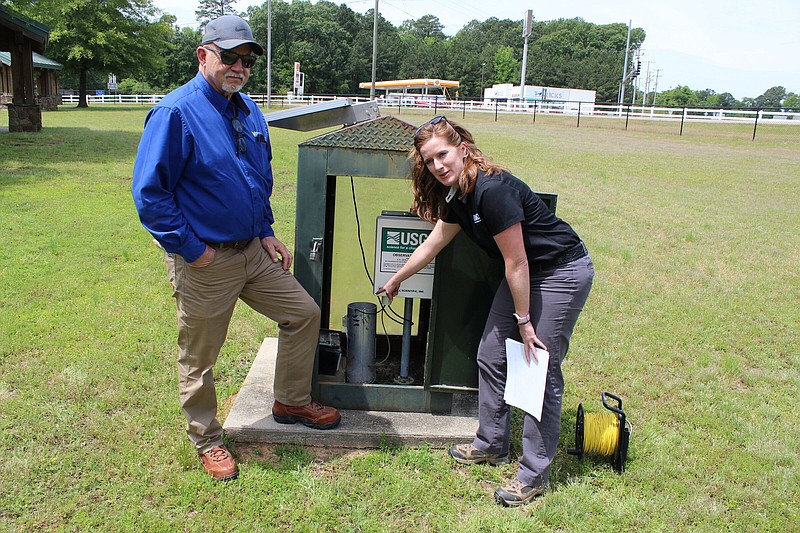EL DORADO -- A groundwater report last month warned current pumping levels from Arkansas' primary aquifers are not sustainable in the long term, but groundwater levels at the Sparta aquifer in Union County have risen significantly because they are already doing what the report recommends -- using both surface and groundwater -- to avoid depleting the aquifer.
Union County is singled out in last month's groundwater report:
"The Sparta aquifer in the South Arkansas study area continues to see recovery where historical drawdown has been the most severe. Union County continues to experience the most recovery, having the greatest average change in the five and ten-year intervals ... several wells have positive water level change values, as much as 56 feet over the 10-year period."
Union County completed infrastructure in the early 2000s to offer "conjunctive" ground and surface water, which caused groundwater levels at the Sparta aquifer in Union and four other contiguous Arkansas counties -- deemed the state's first critical groundwater area in 1996 -- as well as three northern Louisiana parishes to rise significantly.
The groundwater level at the Monsanto monitoring well in Union County rose 120.5 feet in April, since industrial conversion from the Sparta aquifer groundwater to surface water from the Ouachita River in 2004, according to Union County Water Conservation Board documents.
"The groundwater levels are rising because of conjunctive use and due to what I would call prudent conservation efforts by local citizens ... and the small businesses, which are not hooked to the alternative water system, likewise adopted a progressive approach to conserve water," said Robert Reynolds, founding president of the Union County Water Conservation Board who served the board from 1999 to 2015 who now operates as a volunteer advisor.
Rising groundwater levels in the board's monitoring wells also show the county is pumping groundwater at a rate that allows the aquifer to recharge and recover naturally, Union County Water Conservation Board Projects Manager and Grants Administrator Sherrel Johnson said.
The Union County Water Conservation Board established a 28-well dedicated Monitoring Well network in 2002 thanks to a $1 million U.S. Environmental Protection Agency study grant that included eight U.S. Geological Survey groundwater level monitoring wells, Johnson said.
Water levels at all of the board's 16 dedicated groundwater level monitoring wells have risen since the local industries began converting to surface water, Johnson said.
The changes made in Union County appear to be working and could be an example for other counties as the state works to preserve its aquifers.
When asked what first steps he recommended for other counties that want to use more surface water: "Consider establishing a water conservation board on their own and or an adjacent county," Reynolds said.
The Arkansas Natural Resources Commission -- which became the Natural Resources Division of Agriculture in 2015 -- told the board in 1997 the county needed to solve its rapidly declining aquifer problem, Johnson said.
The Arkansas Natural Resources Commission declared Union County among the state's first five critical groundwater counties in 1996; the Sparta aquifer was declining as much as seven inches per year in some parts of the county by 1997, so the county formed a coalition to address the issue as an economic development priority and the Union County Water Conservation Board was formed in 1999.
The U.S. Department of the Interior U.S. Geological Survey (USGS) worked with the board and the state's congressional delegation to fund a sustainable yield study, published in 2000.
But the board was told much earlier -- in 1998 -- that Union County needed to reduce daily consumption of Sparta aquifer water by 72% from 21 million gallons per day -- the county's only source for drinking and industrial water -- to 7 million gallons per day within five years or less or risk causing the aquifer irreparable harm, Board documents stated.
Union County now uses an average of seven to eight million gallons per day of water from the Sparta aquifer -- considered sustainable based on the 2000 USGS sustainable yield report -- and 21 to 23 million gallons of water per day of lightly treated industrial water from the Ouachita River, which is delivered via infrastructure completed in 2004.
The Ouachita River Intake infrastructure includes a 65 million gallons of water per day intake and water pump station in Calion, an above ground storage tank and pump station, the Union County Water Conservation Board Sherrel Johnson Water Clarification Facility -- a water treatment plant -- as well as approximately 23 miles of pipeline. The pipeline supplies three major area industries, El Dorado Chemical, Delek and Lanxess, which were once the county's largest single users of groundwater from the Sparta aquifer but have since converted to using surface water, Johnson said.
The water treatment plant can clarify 13,000 gallons a minute, or up to 45 million gallons per day at maximum capacity.
"Right now, we're running about 18 million gallons a day this time of year, in the hot summer time, this year we should run from 24 to 25 million gallons a day," said Tom Harrel, water treatment technician at the Union County water treatment plant.
El Dorado Chemical is an ammonium nitrate manufacturer that now uses 100% alternative surface water, Delek is a petroleum refinery that now uses approximately 30% surface water and Lanxess, a German-French jointly owned bromium extraction facility, uses between 50 and 60% alternative surface water, Reynolds said.

